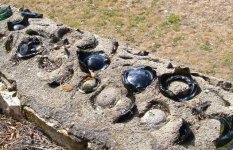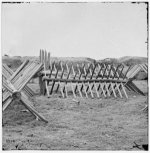kenb
Bronze Member
Up from the depths of history
A remnant of the Revolution is pulled from the Delaware.
By Edward Colimore
Inquirer Staff Writer
In a small survey boat, maritime archaeologist J. Lee Cox Jr. was checking the bottom of the Delaware River at the Sunoco Logistics pier in South Philadelphia when he got a hit on the side-scan sonar.
A pipe? A log? A hazard to the oil tankers docking nearby?
No one was sure until a diver was sent down weeks later and found a strange pointed object buried in the muck about 40 feet down.
This week, Cox identified it as the business end of a cheval-de-frise, an iron-tipped log once embedded in the river, along with many others, to gore the hulls of British warships menacing Philadelphia in the mid-1770s. It had been silently resting not far from where oil-laden Sunoco tankers have berthed since Philadelphia's industrial age.
The cheval-de-frise was in excellent condition, a rare historic find after more than two centuries in the river.
"I had never seen one up close," Cox said yesterday as he gazed at the relic at Sunoco Logistics' Fort Mifflin Terminal. "This is great."
The company donated the cheval-de-frise to the Independence Seaport Museum, which plans to conserve it over the next year and make it the cornerstone of its growing Revolutionary War collection.
Museum officials yesterday picked up the 11-foot, 2-inch object by van and transferred it to the Penn's Landing museum, where experts will take about a year to conserve it.
The relic will be placed in a tank of polyethylene glycol, which will permeate and preserve the wood.
"It's in fabulous shape," said museum curator Craig Bruns.
"Wow!" said Michele DiGirolamo, a museum spokeswoman, as she got her first look. "That's scary-looking."
The yellow pine log, with its heavy iron tip, was once bolted into a wooden-framed box anchored with rocks. Poised on the river bottom with scores of other chevaux-de-frise, it was a formidable defense against British ships.
Bruns said the newly discovered relic was probably placed in the river in 1775, at a time when the Pennsylvania Council of Safety, under the direction of Benjamin Franklin, was overseeing the colony's defense.
After the Revolution started, the chevaux-de-frise were used by Continental forces - in conjunction with Fort Mifflin and Fort Mercer, across the river in New Jersey - to oppose the British resupply of troops occupying Philadelphia in the winter of 1777-78. Not coincidentally, that was the winter that Washington and the Continental Army spent at Valley Forge.
"The delay of the resupply was vital," said Bruns. "The ships could carry huge amounts of supplies that the troops needed. The river was the highway, and we were blocking the highway."
The French term cheval-de-frise means "horse from Friesland," a part of the Netherlands ruled by a powerful tribe during the Dark Ages.
The spiked logs didn't always rip open the thick wooden hulls of British ships. But just getting hung up on one could be catastrophic - when caught in the kill zone between Fort Mifflin and Fort Mercer and faced with fire from smaller vessels.
"We had a lot of moxie as Americans to oppose the British coming up in their big ships, and holding them off for weeks," said Cox.
The chevaux-de-frise were removed from the river in 1784, museum officials said. Part of at least one remained and was apparently pushed closer to the Fort Mifflin Terminal during river-dredging operations.
And there, the mud helped preserve it, said Cox, director of Dolan Research, Maritime Archaeology and Underwater Survey.
He and Mark I. Klein, manager of field services for S.T. Hudson Engineers in Camden, were working together over the summer on an annual survey of the river bottom when the then-unknown object was spotted on sonar, along with a nearby chunk of concrete.
A report on the find was prepared for Sunoco Logistics, which is responsible for making sure that the huge oil tankers can dock safely to offload their cargo.
"If it's high enough off the bottom, they'll ask us to investigate and remove it," Klein said. "We winched it up on Wednesday, brought it to the pier, and then lifted it up to the ground with a crane."
At first Klein and the other workers thought it was part of a pier.
Klein took photos and e-mailed them Monday to Cox, an S.T. Hudson subcontractor, who - together with Bruns - identified the historic find. He then called John C. Legge Jr., the operations manager for Sunoco Logistics, to inform him.
"We wanted to share it with people, so we donated it to the museum," said Legge. "I think it's amazing that it's in such good shape after over two hundred years."
Bruns said Cox, S.T. Hudson, Sunoco Logistics and the Army Corps of Engineers are guardians of river history - "the first line to catch relics. What's important is finding them and getting them to where they need to be so we can all share in them."
Bruns said the Delaware River is still full of surprises.
"It keeps a lot of these secrets and we bump into them every once in a while," he said. Finding the cheval-de-frise "throws you back in time."
kenb
A remnant of the Revolution is pulled from the Delaware.
By Edward Colimore
Inquirer Staff Writer
In a small survey boat, maritime archaeologist J. Lee Cox Jr. was checking the bottom of the Delaware River at the Sunoco Logistics pier in South Philadelphia when he got a hit on the side-scan sonar.
A pipe? A log? A hazard to the oil tankers docking nearby?
No one was sure until a diver was sent down weeks later and found a strange pointed object buried in the muck about 40 feet down.
This week, Cox identified it as the business end of a cheval-de-frise, an iron-tipped log once embedded in the river, along with many others, to gore the hulls of British warships menacing Philadelphia in the mid-1770s. It had been silently resting not far from where oil-laden Sunoco tankers have berthed since Philadelphia's industrial age.
The cheval-de-frise was in excellent condition, a rare historic find after more than two centuries in the river.
"I had never seen one up close," Cox said yesterday as he gazed at the relic at Sunoco Logistics' Fort Mifflin Terminal. "This is great."
The company donated the cheval-de-frise to the Independence Seaport Museum, which plans to conserve it over the next year and make it the cornerstone of its growing Revolutionary War collection.
Museum officials yesterday picked up the 11-foot, 2-inch object by van and transferred it to the Penn's Landing museum, where experts will take about a year to conserve it.
The relic will be placed in a tank of polyethylene glycol, which will permeate and preserve the wood.
"It's in fabulous shape," said museum curator Craig Bruns.
"Wow!" said Michele DiGirolamo, a museum spokeswoman, as she got her first look. "That's scary-looking."
The yellow pine log, with its heavy iron tip, was once bolted into a wooden-framed box anchored with rocks. Poised on the river bottom with scores of other chevaux-de-frise, it was a formidable defense against British ships.
Bruns said the newly discovered relic was probably placed in the river in 1775, at a time when the Pennsylvania Council of Safety, under the direction of Benjamin Franklin, was overseeing the colony's defense.
After the Revolution started, the chevaux-de-frise were used by Continental forces - in conjunction with Fort Mifflin and Fort Mercer, across the river in New Jersey - to oppose the British resupply of troops occupying Philadelphia in the winter of 1777-78. Not coincidentally, that was the winter that Washington and the Continental Army spent at Valley Forge.
"The delay of the resupply was vital," said Bruns. "The ships could carry huge amounts of supplies that the troops needed. The river was the highway, and we were blocking the highway."
The French term cheval-de-frise means "horse from Friesland," a part of the Netherlands ruled by a powerful tribe during the Dark Ages.
The spiked logs didn't always rip open the thick wooden hulls of British ships. But just getting hung up on one could be catastrophic - when caught in the kill zone between Fort Mifflin and Fort Mercer and faced with fire from smaller vessels.
"We had a lot of moxie as Americans to oppose the British coming up in their big ships, and holding them off for weeks," said Cox.
The chevaux-de-frise were removed from the river in 1784, museum officials said. Part of at least one remained and was apparently pushed closer to the Fort Mifflin Terminal during river-dredging operations.
And there, the mud helped preserve it, said Cox, director of Dolan Research, Maritime Archaeology and Underwater Survey.
He and Mark I. Klein, manager of field services for S.T. Hudson Engineers in Camden, were working together over the summer on an annual survey of the river bottom when the then-unknown object was spotted on sonar, along with a nearby chunk of concrete.
A report on the find was prepared for Sunoco Logistics, which is responsible for making sure that the huge oil tankers can dock safely to offload their cargo.
"If it's high enough off the bottom, they'll ask us to investigate and remove it," Klein said. "We winched it up on Wednesday, brought it to the pier, and then lifted it up to the ground with a crane."
At first Klein and the other workers thought it was part of a pier.
Klein took photos and e-mailed them Monday to Cox, an S.T. Hudson subcontractor, who - together with Bruns - identified the historic find. He then called John C. Legge Jr., the operations manager for Sunoco Logistics, to inform him.
"We wanted to share it with people, so we donated it to the museum," said Legge. "I think it's amazing that it's in such good shape after over two hundred years."
Bruns said Cox, S.T. Hudson, Sunoco Logistics and the Army Corps of Engineers are guardians of river history - "the first line to catch relics. What's important is finding them and getting them to where they need to be so we can all share in them."
Bruns said the Delaware River is still full of surprises.
"It keeps a lot of these secrets and we bump into them every once in a while," he said. Finding the cheval-de-frise "throws you back in time."
kenb







